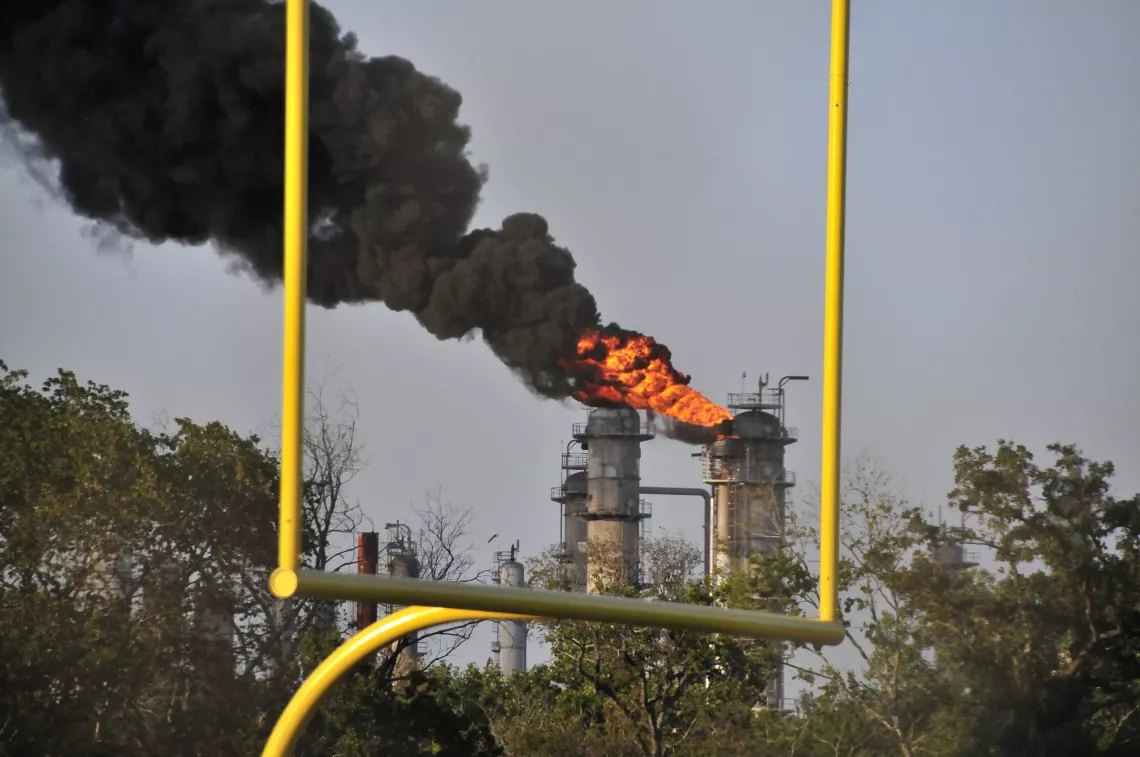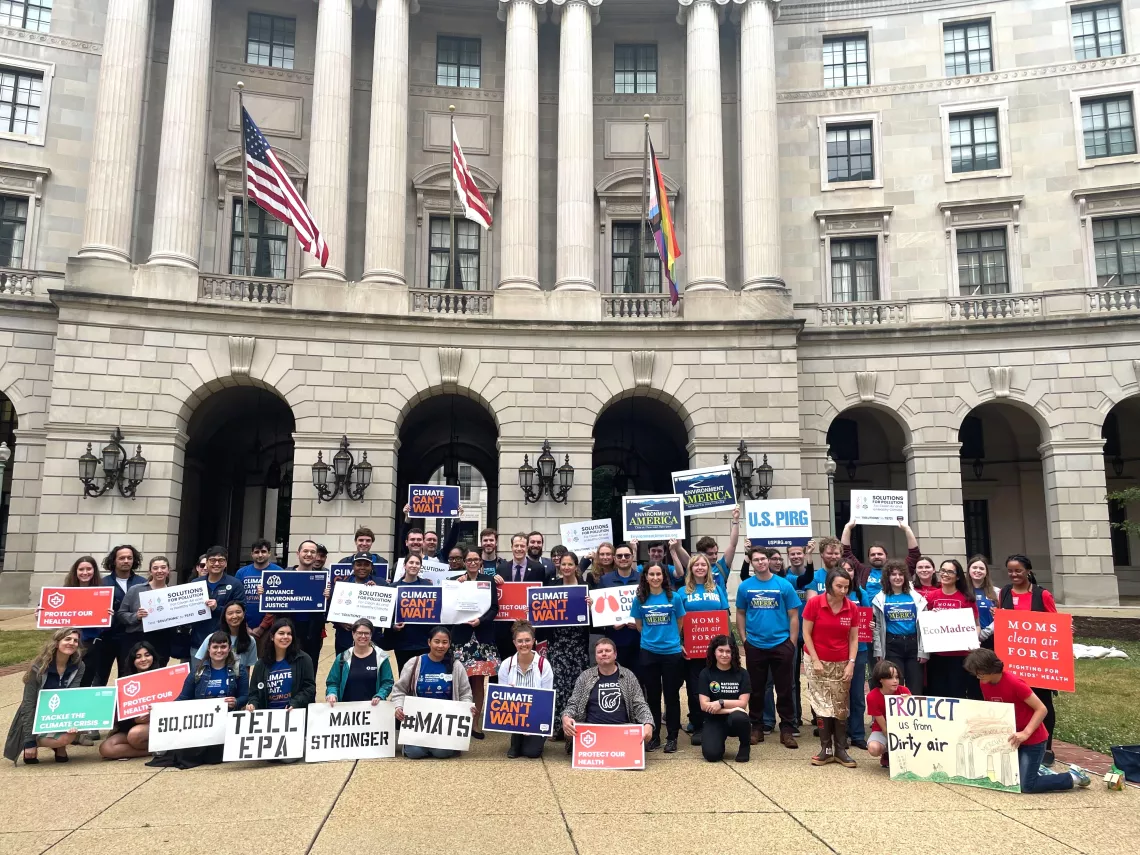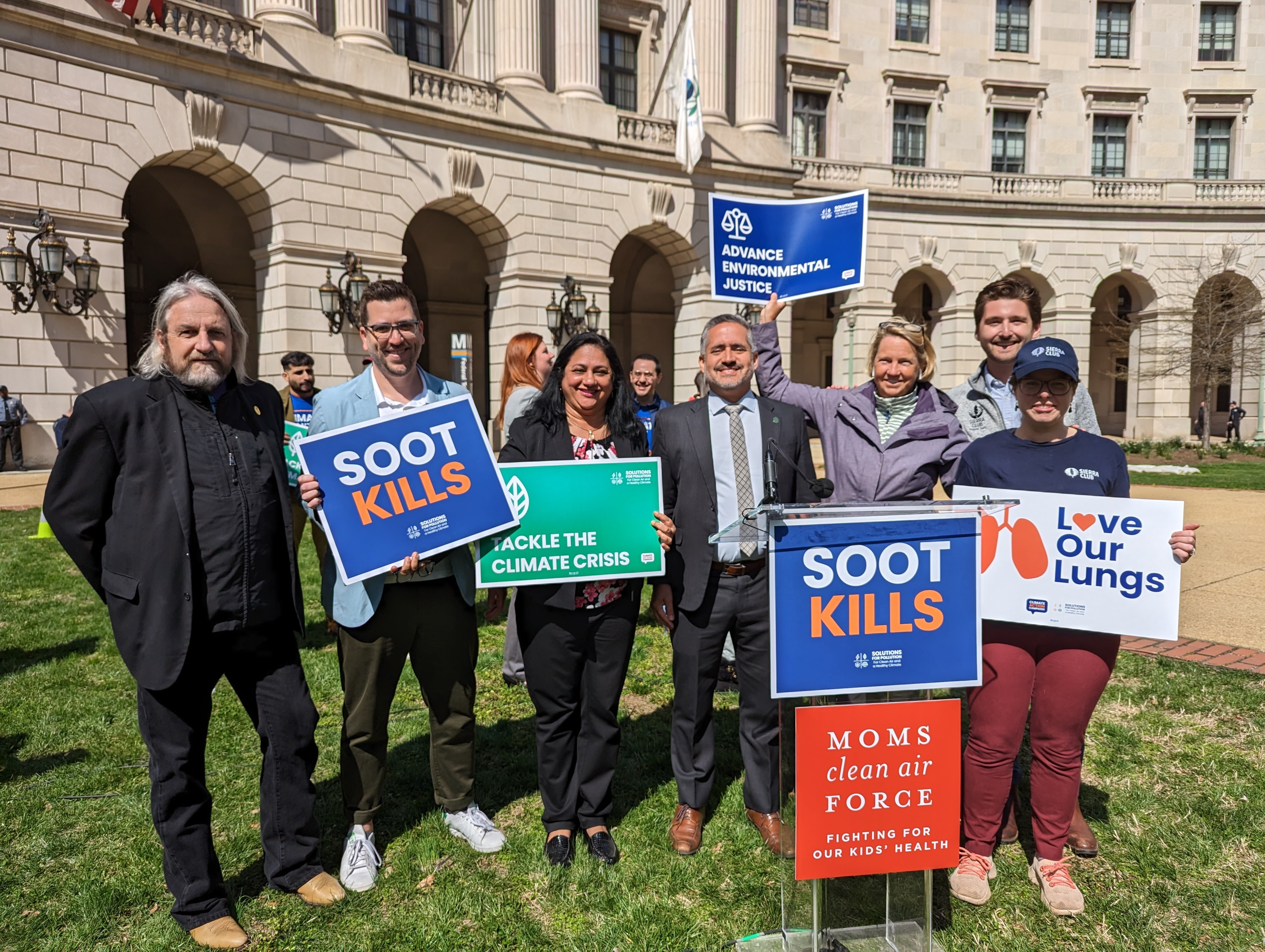2023 brought devastating wildfires and hurricanes, extreme heat waves, and what felt like one dire climate prediction after another. But in the past year, we also saw abundant reason for hope, joy, and celebration. In 2023, we pushed the Biden Administration to propose stronger standards for deadly soot pollution, climate-destabilizing carbon pollution, mercury and other air toxics, and cross-state smog pollution, achieved a retirement announcement for the 377th coal plant since 2010, earned stronger protections from coal pollution in our waterways, and so much more.
In a testament to the transformative power of collective action, energy from wind and solar power is projected to surpass energy from coal next year, bringing us even closer to our shared goal of 100 percent clean energy by 2035. Join us in a moment of reflection and celebration as we acknowledge our achievements, and learn how you can take action in 2024.
Strengthened Air Quality Standards
Championed Strong Soot Standards Against Big Polluters
EPA set the tone for this year of historic climate and clean air victories by proposing to strengthen the National Ambient Air Quality Standards (NAAQS) for soot, also known as particulate matter, in January (Sierra Club in the news). But EPA’s proposal stopped short of guaranteeing the strongest possible protections, so together, a diverse coalition of public health, climate, and community organizations rallied together this summer to collect over 600,000 public comments in support of stronger soot standards. As big polluters lobbied against the rule, we met the moment with a powerful advertising and advocacy campaign and released new research demonstrating how federal funding opportunities can help communities meet strong soot standards.
What’s next? The Biden Administration is finalizing soot standards right now. Tell President Biden to fulfill his promise to advance clean air and healthy communities with strong soot standards at sc.org/soot.
Over One Million Voices Spoke Up for Climate Solutions
In May, President Biden’s EPA announced a new plan to combat climate change and significantly reduce carbon dioxide emissions from power plants (Sierra Club in the news). These proposed carbon pollution standards build on the continued efforts of the Biden Administration to address the climate crisis and protect public health through landmark legislation and other strong air pollution protections from EPA. Chief Energy Officer Holly Bender urged communities to speak up and share why the carbon pollution standards mattered to them in a powerful video, and in August, the Sierra Club and partners delivered more than one million public comments in support of strong carbon pollution standards for fossil fuel power plants.
What’s next? A final rule is expected in spring 2024, and we will continue to push the Biden Administration to improve key aspects of the rule to provide greater emission reductions, include more detailed and effective community outreach requirements for state regulators implementing the standards at existing power plants, and ensure that the rule’s public health benefits are equitably distributed.
Closed Unlawful Polluter Loopholes

An SSM event captured by Bryan Parras
In July, following years of advocacy and legal action from Sierra Club, partners, and community groups, EPA closed an illegal loophole in the Clean Air Act that allowed fossil fuel power plants and industrial facilities to release unlimited amounts of dangerous air pollution during startup, shutdown, and malfunction (SSM) events with impunity (Sierra Club in the news). Big polluters fought back, challenging EPA’s action in court, and Sierra Club and several partners have joined EPA in their legal defense of the action.
What’s next? Thousands of people have already urged EPA to close these deadly loopholes. In 2024, we’ll continue to defend EPA’s action to close some of the loopholes for the oil and gas and steel industries, and to push to remove similar loopholes from regulations for other industries.
Strengthened Critical Protections Against Mercury and Air Toxics
There is no safe level of mercury exposure, and coal-fired power plants remain one of the largest sources of mercury pollution. In February, EPA restored the legal underpinnings of the Mercury and Air Toxics Standards (MATS). We secured another critical win against dangerous mercury pollution when EPA proposed strengthening protections against heavy metals, mercury and other hazardous air pollution emitted from power plants in April, protecting vulnerable communities from some of the most dangerous types of air pollution (Sierra Club in the news).
What’s next? Thousands of supporters told EPA to clean up dirty coal plants and keep mercury and heavy metals, like arsenic and lead, out of our air, and we hand-delivered those comments to EPA alongside our coalition partners in June. A final rule is expected in early 2024.

Sierra Club members and partners deliver thousands of public comments in support of strong MATS
Fought Cross-State Air Pollution with the Good Neighbor Rule
Air pollution doesn’t stop at state lines, and smog pollution from power plants and industrial facilities can harm communities hundreds of miles from the original source of pollution. In March, EPA finalized the Good Neighbor Rule to protect residents in dozens of states who are unknowingly and unwillingly subjected to smog pollution from power plants and industrial facilities in other states. This final plan was released in response to legal action from Sierra Club, Air Alliance Houston, Center for Biological Diversity, Citizens for Pennsylvania’s Future, Clean Air Council, and Texas Environmental Justice Advocacy Services, all represented by Earthjustice and the Clean Air Task Force. Fossil fuel companies, utilities, and polluter states have filed legal challenges to the rule, and some have filed requests for an emergency stay of the rule before the Supreme Court (Sierra Club in the news). But states that have implemented the rule are already seeing big benefits, as harmful NOx pollution (a key ingredient in smog) has dropped 18 percent in the 10 states that participated in the program in 2023.
What’s next? Sierra Club and partners have submitted briefs in support of the Good Neighbor Rule. The Supreme Court will hear oral arguments on the emergency stay requests to the Good Neighbor Rule in February.
Protected the Health Of Our Communities and Waterways from Coal Pollution
Soot pollution from coal-fired power plants across the United States was responsible for at least 460,000 deaths over the past two decades, causing twice as many premature deaths as previously estimated. From coal mining communities to towns and cities that have uncovered coal trains rolling through, to fenceline communities dealing with the constant burn at coal-fired power plants, millions of people are harmed by coal pollution. In 2023, we took action to close dangerous coal ash loopholes, strengthen wastewater treatment standards for coal plants, and address coal dust pollution.
Closed Coal Ash Loopholes, Protecting Communities and Groundwater
Despite being filled with some of the nastiest contaminants around, from carcinogens like arsenic, cadmium and chromium to neurotoxins such as lead and lithium, hundreds of toxic coal ash dump sites have been allowed to operate without critical safeguards for years. As a result of a lawsuit from Sierra Club and our partners, EPA proposed two new rules in May to protect the public from millions of tons of toxic coal ash sitting in old landfills and ponds across the country. When finalized in early 2024, the proposal will regulate coal ash disposed of in old landfills, retired power plants, and other fill areas at power plants, not just ash in “active” landfills, safeguarding nearby communities and groundwater from the harmful impacts of coal ash.
Strengthened Wastewater Treatment Rules for Coal Plants
In March, EPA announced a new rule to require modern wastewater treatment at all remaining coal plants, protecting hundreds of communities from mercury, arsenic, and other toxic pollution that has been dumped into U.S. waterways for decades (Sierra Club in the news). The updated rule, called Effluent Limitations Guidelines (ELGs), will apply to every U.S. power plant that burns coal, and will prevent over 584 million pounds of pollutants from being discharged into U.S. waterways each year. During two days of virtual public hearings in April around the rule, dozens of supporters testified in favor of EPA’s proposal, including at least 18 Sierra Club staff and volunteers.
Took Steps to End Coal Train Operators’ Free Ticket to Pollute
Unburned coal and coal dust are found everywhere coal trains travel, from coal export terminals in Norfolk, Virginia to Richmond, California - and everywhere in between. This happens because railroads transport coal, unlike any other commodity, in uncovered rail cars. Coal dust and chunks spew into the air, threatening the health of adjacent homes, communities, and waterways all along the route. These discharges of unburned coal into our nation’s waterways violate the Clean Water Act, yet no federal agency has ever addressed the problem, essentially giving coal train operators a free pass to pollute. People of color, including Black, Hispanic, and Asian people, have a higher risk of premature death from particle pollution than white people, and unregulated coal train pollution exacerbates existing environmental and social inequalities. Sierra Club and more than a dozen other environmental and public health organizations filed a petition for rulemaking with the EPA in September, calling upon the agency to stop harmful coal pollution from open-top trains carrying coal by requiring coal train operators to obtain a permit for their water pollution (Sierra Club in the news).
What’s next? Tell EPA to end coal train operators’ free ticket to pollute by signing the petition.
Released New Analyses on the Deadly Impact of Fossil Fuels
Throughout the year, Sierra Club experts released several additional reports highlighting the role the power sector plays in climate pollution, and how everyone, from local communities to national leaders, can take action to push utilities to transition to renewable energy.
Exposed the Dirty Truth About Utility Climate Pledges
Our annual report, The Dirty Truth About Utility Climate Pledges, revealed that the 77 utility companies most invested in fossil fuels are planning to replace just 30 percent of their existing fossil fuel generation with clean energy by 2030 (Sierra Club in the news). The report, supported by Bloomberg Philanthropies’ Beyond Carbon, was accompanied by an interactive webpage users can use to see their utility’s score and what progress–if any–the utility has made toward transitioning to cleaner, more affordable energy.
We shared the report through a national press release and a dozen locally-tailored statements emphasizing the performance of specific utilities, a story in Sierra Magazine, a video posted across social media platforms, and a digital advertising campaign directed at five utilities that received failing grades in the report.
Additional Reports:
- Out of Control: The Deadly Impact of Coal Pollution. The Sierra Club’s Beyond Coal Campaign investigated the extent and effect of soot pollution from coal-fired power plants in the United States, where that pollution is felt, which plants and parent companies are at fault, and what can be done to ensure all communities have clean air.
- Under Controlled: How Federal Rules Could Curb Coal Plant Pollution. This report is an analysis of the impact that strengthened and enforced Clean Air Act standards for ozone pollution, regional haze pollution, sulfur dioxide, and mercury and other toxic air pollutants could have on coal plants across the country.
- Leveraging Federal Funding the Meet and Exceed Soot Standards. This report describes how provisions in the Inflation Reduction Act and Bipartisan Infrastructure Law present opportunities for state and local governments to create safer, healthier communities and cost-effectively meet national air quality standards for particulate matter.
Advanced the Transition from Dirty Fossil Fuels to Renewable Energy
Secured the Retirement Announcement of the 377th Coal Plant
Across the country, our campaigns are shutting down dirty coal plants and seeking justice for the affected people and environmental resources that surround them. To date, the Sierra Club’s Beyond Coal campaign has secured retirement announcements for 377 coal plants in the U.S., and we’re tirelessly working to retire the last 153 coal plants across the country. In 2023 alone, we achieved retirements or retirement announcements of eight additional coal plants and took 11,311 megawatts of dirty coal out of our communities and the air we breathe.
This year, we achieved retirements or retirement announcements for the Cumberland Coal Plant (Tennessee), J.K Spruce (Texas), Homer City (Pennsylvania), F.B. Culley (Indiana), Tolk (Texas), Warrior Run (Maryland), Wateree (South Carolina), Virginia Tech (Virginia), and GRDA (Oklahoma).
Stopped Dirty Gas Plants
This year, we terminated the 133rd methane gas plant since the beginning of 2020, ending over 54,000 MW of proposed dirty gas. In a demonstration of the effectiveness of our campaigns to halt new gas plants across the country, only one out of every 10 MW of new methane gas capacity that has been planned since 2020 has been able to move forward, to either construction or operation. In New England, we achieved significant victories this year as we worked alongside local partners to advocate and organize against the proposed Killingly Energy Center in Connecticut.
Our organizing and legal strategy led to significant delay in the water quality certification for the proposed pipeline (a final certification was never issued) and eventually a canceled capacity contract with ISO-NE due to the plant’s delays that the owners could not overcome. And together, we helped shift Governor Lamont’s goals past just stopping Killingly. The Lamont administration now wants to leave the regional market or overturn the biased market rules that favored gas, to stop subsidizing new gas hookups in buildings, and to move beyond gas entirely. In 2024, we will continue fighting the advancement of fossil fuels at every turn, using every tool available to stop further methane gas plants.
Advanced Renewable Energy Across the Country
As we continued to retire coal plants and stop the construction of new gas plants, we simultaneously worked alongside our partners to equitably and efficiently advance more affordable and reliable renewable energy solutions that bring jobs and investment to local communities. Since the passage of the Inflation Reduction Act last year, the Biden administration’s law has created more than 210,000 jobs, thanks to $310 billion in new investments in clean energy projects.
2023 was a record-breaking year for solar power, bringing the largest annual addition of solar installations in U.S. history, alongside significant additions of battery storage. This was also a year of remarkable progress for offshore wind, with clean wind energy sent to the grid from the first turbine at the 132MW South Fork offshore wind project, the first ever commercial offshore wind project in the U.S., and with construction underway the 806MW Vineyard offshore wind project. The 2.6GW Coastal Virginia Offshore Wind project won federal approval this year, clearing a major hurdle for the largest offshore wind farm in the US so far.
Worked to Help Implement the Inflation Reduction Act in the Energy Sector
This year also marked important progress in the implementation of the Inflation Reduction Act, President Biden’s landmark climate legislation, with major advances being made in programs that will help transform and clean up the energy sector. Across many of the IRA’s signature programs, we’ve seen overwhelming interest in funding and an eagerness to transition away from dirty fuels and towards clean energy. The success of these and other efforts within the Inflation Reduction Act will help create jobs and lower energy costs for families. Here are some key highlights.
A “New ERA” for Rural Cooperatives
The September 15 deadline for applications to the “Empowering Rural America” or “New ERA” program—$9.7 billion in competitive USDA grant funding designed to bring good-paying jobs, investment, and clean energy to rural communities—brought in letters of intent from 157 rural cooperatives across 40 states and Puerto Rico seeking more than $93 billion in funding for 750+ clean energy projects. Since the very start, this program has had the greatest potential in shifting some of the most recalcitrant utilities from skeptics to clean energy enthusiasts and leaders. With requests totaling more than 10 times the program size, it is encouraging to see the overwhelming enthusiasm and interest this program has generated. More than 200,000 Sierra Club members are also co-owners of an electric cooperative, and we’ll continue to work to ensure that these and all utilities shift even further away from fossil fuels.
Environmental Justice and Climate Pollution Reduction Grants
Funding for the EPA’s $3 billion Environmental and Climate Justice Community Change Grants and $5 billion Climate Pollution Reduction Grants (CPRG) programs will soon be going out the door to cities, states, and tribal governments in early 2024, and we’ll continue to work with eligible recipients and stakeholders to ensure the most ambitious and forward-thinking pollution reduction plans are adopted, specifically in communities that are disadvantaged or otherwise would not have access to capital.
Solar for All
The extended October deadline for applications to the EPA’s Solar for All program—$7 billion in competitive grant funding through the Greenhouse Gas Reduction Fund to expand access to affordable and clean residential solar energy for disadvantaged communities and low-income households—resulted in more than 270 letters of intent, requesting over $40 billion in funding from the program.
This year, we saw the power of collective action as we helped strengthen pollution standards, shut down coal plants and stop new gas plants, build record-breaking amounts of renewable energy, advance President Biden’s historic climate and clean energy law, and so much more. Now, we look ahead to 2024 with confidence in our power to spark change across the energy sector and beyond.
Jump into the new year by taking action with us. Tell President Biden & Administrator Regan: Time for Strong Solutions for Pollution!
